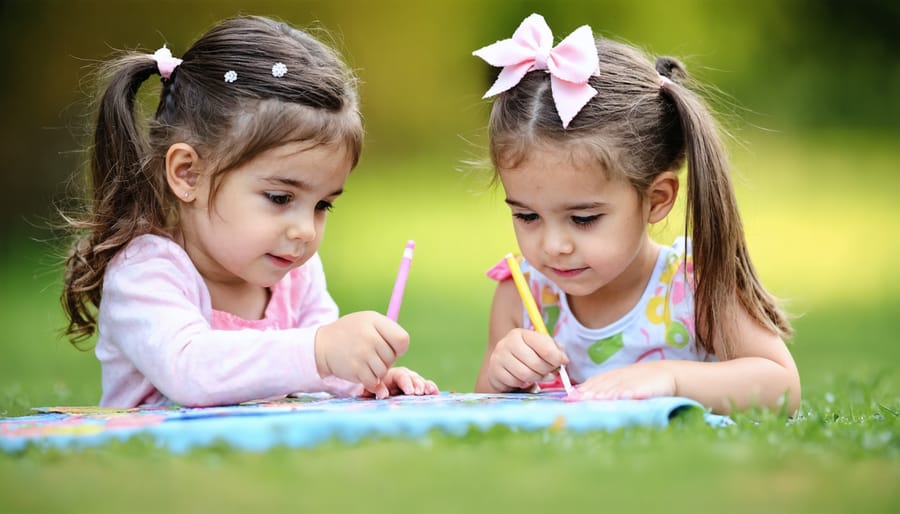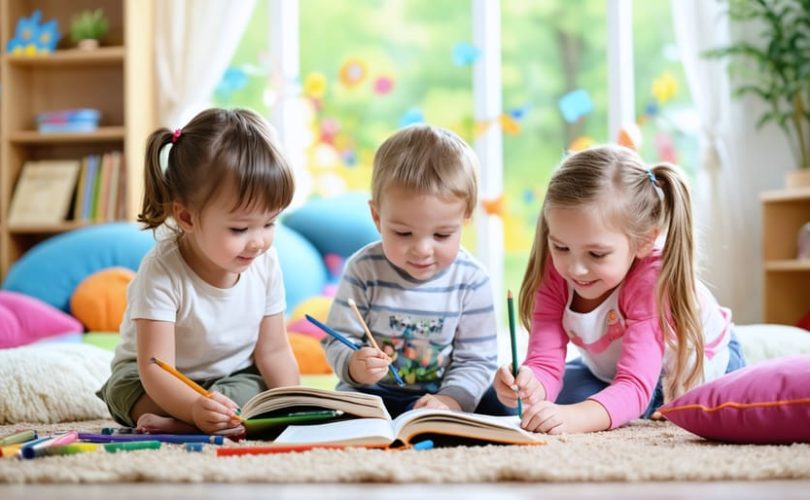Transform everyday moments into powerful opportunities for emotional growth through purposeful well-being activities. Understanding the role of play in child development reveals how simple, intentional activities can nurture resilience, emotional intelligence, and mental wellness in children.
Whether it’s creating a calm-down corner with soft cushions and sensory tools, or establishing a daily “feelings check-in” ritual during breakfast, these activities provide children with essential emotional skills they’ll carry throughout life. Research shows that children who regularly engage in well-being activities demonstrate improved self-regulation, stronger social connections, and enhanced problem-solving abilities.
As parents and caregivers, we have the unique opportunity to weave these meaningful moments into our daily routines. From mindful breathing exercises during bedtime to collaborative art projects that express emotions, each activity builds a foundation for lasting emotional health. The key lies not in perfect execution, but in creating consistent, supportive spaces where children feel safe to explore, express, and understand their emotional world.
The Science Behind Play and Emotional Development
How Play Activates Emotional Learning Centers
When children engage in play, their brains light up with activity, particularly in regions responsible for emotional processing and learning. During playful moments, the amygdala and hippocampus – our emotional control centers – become highly active, helping children process and understand their feelings in a safe, natural way.
Dr. Sarah Thompson, a child development specialist, explains: “Play acts like a gentle teacher for emotions. When children act out scenarios with toys or engage in imaginative play, they’re actually rehearsing emotional responses and building neural pathways that will serve them throughout life.”
Through play, children release feel-good hormones like dopamine and oxytocin, which not only make the experience enjoyable but also create positive associations with emotional learning. Whether it’s sharing toys with friends, working through pretend conflicts with stuffed animals, or expressing joy during active games, each playful interaction strengthens their emotional intelligence.
Parents often notice how their children seem more balanced and centered after engaging in unstructured play. This isn’t coincidental – play provides a natural outlet for processing complex feelings while building crucial emotional regulation skills.

The Stress-Reducing Power of Play
When children engage in play, they’re doing more than just having fun – they’re actively managing their stress levels in a natural, healthy way. Research shows that playful activities trigger the release of endorphins and reduce cortisol levels, helping children regulate their emotional responses to challenging situations.
Dr. Sarah Chen, a child psychologist, explains: “Play acts as a pressure valve for children, allowing them to process complex emotions and daily stresses in a safe, controlled environment.” Whether it’s running around the playground, engaging in imaginative play, or working on a puzzle, these activities provide crucial outlets for pent-up energy and anxiety.
Parents often notice that children become more relaxed and centered after playtime. This isn’t coincidental – play helps children develop coping mechanisms they can use throughout their lives. Through play, they learn to manage frustration, practice problem-solving, and develop emotional resilience.
Even simple activities like coloring or building with blocks can have a calming effect. These quiet play moments allow children to focus their minds and find their own pace, naturally reducing anxiety and promoting emotional balance.
Essential Play Activities for Emotional Growth
Imaginative Play and Emotional Expression
Through role-playing and emotional development, children find a safe space to explore and express their feelings. When your child pretends to be a doctor treating a sick teddy bear or a teacher helping struggling students, they’re actually processing real emotions and developing empathy.
Sarah Thompson, a child psychologist with 15 years of experience, shares: “During imaginative play, children naturally work through scenarios that might worry or excite them. It’s their way of making sense of the world and their place in it.”
Consider four-year-old Maya, who started playing ‘new student’ games after feeling nervous about starting preschool. Through this play, she worked through her anxiety in a controlled environment, eventually becoming more confident about the real transition.
To encourage emotional expression through play:
– Create a dress-up corner with various costumes
– Provide puppets for storytelling
– Join their pretend scenarios when invited
– Ask open-ended questions about their characters’ feelings
– Allow them to lead the play narrative
Remember that some children might express challenging emotions during play – this is normal and healthy. By providing a supportive, judgment-free environment, you’re helping your child develop crucial emotional regulation skills that will serve them throughout life.

Social Play and Emotional Intelligence
Social play activities are powerful tools for developing children’s emotional intelligence and interpersonal skills. When children engage in group play, they naturally learn to recognize and respond to others’ feelings, share resources, and resolve conflicts – all essential components of emotional development.
Simple activities like “emotion charades” where children act out and guess different feelings help them build emotional vocabulary and recognition skills. Cooperative games that require teamwork, such as building a block tower together or playing “follow the leader,” teach children how to work with others and manage group dynamics.
Dr. Sarah Chen, child psychologist, notes: “Through social play, children learn empathy in a natural, engaging way. When a playmate is sad about losing a game, for instance, children have authentic opportunities to practice compassion and support.”
Consider organizing regular playgroups where children can practice these skills. Activities like puppet shows allow children to explore different perspectives and emotions through storytelling. Group art projects encourage sharing, turn-taking, and celebrating others’ contributions.
Remember to create a safe emotional environment where children feel comfortable expressing their feelings. Validate their emotions and guide them through challenging social situations. When children feel supported, they’re more likely to develop strong emotional intelligence and lasting friendships.
Include reflection time after group activities, asking children how they felt and what they learned about working with others. This helps reinforce social-emotional learning and builds self-awareness.
Creative Play and Emotional Release
Creative expression through art, music, and movement provides children with powerful tools to process and express their emotions in healthy ways. When children engage in artistic activities, they often find it easier to navigate big emotions through play than through words alone.
Drawing and painting allow children to express feelings they might struggle to verbalize. A child feeling angry might use bold red strokes or heavy pressure, while calm feelings might emerge as gentle swirls in cooling blues and greens. Keep art supplies readily available and create a judgment-free space where all emotional expression is welcomed.
Music offers another wonderful outlet for emotional release. Whether it’s banging on drums during moments of frustration, swaying to soothing melodies when anxious, or creating silly songs about happy experiences, musical activities help children connect with and process their feelings naturally.
Movement-based activities like dance, yoga, or simple stretching exercises help children release physical tension while processing emotions. As Dr. Sarah Thompson, child psychologist, notes, “When children move their bodies freely, they’re actually moving through their emotions too.”
Consider creating an “emotional expression corner” in your home with various creative materials. This designated space shows children that their feelings are valid and that there are many wonderful ways to express themselves.
Creating a Play-Friendly Environment at Home
Setting Up Emotional Safety Zones
Creating a dedicated emotional safety zone is like building a cozy nest where children feel secure enough to express their feelings freely through play. Start by selecting a quiet corner or space in your home or classroom that’s away from high-traffic areas. This special area should be consistently available and easily accessible to children when they need it.
Make the space inviting by adding soft elements like cushions, blankets, or beanbags. Include items that support emotional expression, such as stuffed animals, emotion cards, or a feelings wheel. Consider adding a small tent or canopy to create a sense of privacy and security.
Dr. Sarah Chen, a child psychologist, explains, “When children have a designated space for emotional expression, they’re more likely to develop healthy coping mechanisms and emotional awareness.” She recommends including sensory items like stress balls, fidget toys, or textured objects that can help children self-regulate.
Keep the space organized with labeled containers for different activities. You might include art supplies for drawing feelings, journals for older children, or puppet characters for storytelling. Remember to establish clear, simple rules about using the space respectfully and keeping it tidy.
Most importantly, ensure children understand that this is a judgment-free zone where all emotions are welcome and valid. Regular check-ins and gentle guidance can help them make the most of this emotional refuge while building crucial social-emotional skills.

Balancing Structured and Free Play
Finding the right balance between structured and free play is essential for your child’s development. Think of structured play as a guided journey, where activities have specific goals and rules, while free play is like giving your child an empty canvas to explore their imagination.
During structured play, you might lead activities like Simon Says, organized sports, or craft projects with step-by-step instructions. These activities help children develop discipline, follow directions, and learn specific skills. Dr. Sarah Chen, a child development specialist, recommends dedicating 30-45 minutes daily to structured activities, especially for younger children.
However, free play is equally crucial. When children engage in self-directed play, they develop creativity, problem-solving skills, and emotional regulation. Whether they’re building with blocks, creating imaginative stories with toys, or exploring outdoor spaces, these moments of unstructured play allow them to process their experiences and emotions naturally.
A balanced approach might look like this: Start the day with a structured activity, such as guided reading or a simple science experiment, then allow time for free play where your child takes the lead. Watch for cues – if your child seems overwhelmed by structured activities, they might need more free play time, or vice versa.
Remember, there’s no one-size-fits-all formula. The key is to observe your child’s engagement and adjust the balance accordingly.
When to Seek Additional Support
While play activities are beneficial for most children’s emotional development, there are times when additional professional support may be needed. As parents and caregivers, it’s important to recognize signs of stress in children that might require more than just play-based interventions.
Pay attention if your child shows persistent behavioral changes lasting more than two weeks, such as:
– Withdrawal from activities they usually enjoy
– Significant changes in sleeping or eating patterns
– Frequent emotional outbursts or difficulty managing feelings
– Regression in previously mastered skills
– Expressing thoughts of hopelessness or worthlessness
– Physical complaints without medical cause
– Difficulty concentrating or sudden academic struggles
Trust your parental instinct. If you feel something isn’t quite right, it’s perfectly okay to seek professional guidance. Remember, early intervention often leads to better outcomes, and asking for help shows strength, not weakness.
Consider reaching out to a mental health professional if:
– Play activities don’t seem to help after consistent implementation
– Your child’s behaviors interfere with daily functioning
– They express thoughts of self-harm or hurting others
– There’s a significant trauma or life change affecting them
– Your family is experiencing high levels of stress
Many mental health professionals incorporate play therapy into their treatment approaches, which can complement the activities you’re already doing at home. They can provide specialized strategies tailored to your child’s specific needs while working alongside your family’s existing routine.
Remember that seeking professional support doesn’t mean you’ve failed as a parent. Instead, it demonstrates your commitment to providing the best possible care for your child’s emotional well-being. Many families find that combining professional guidance with home-based activities creates the most effective support system for their child’s mental health journey.
As we’ve explored throughout this article, well-being activities play a vital role in supporting children’s emotional and mental health development. By incorporating playful elements into daily routines, we create opportunities for children to build resilience, develop social skills, and process their emotions in a safe, nurturing environment.
Remember that every child is unique, and what works for one may not work for another. The key is to remain flexible and observant, adapting activities to match your child’s interests and needs. Whether it’s through creative arts, physical play, mindfulness exercises, or social games, these activities provide essential tools for emotional growth and self-expression.
Start small by introducing one or two activities into your weekly routine. Pay attention to which activities bring joy and engagement to your child, and gradually expand from there. The most important aspect is maintaining consistency while keeping the experience fun and pressure-free.
As parents and caregivers, your involvement in these activities sends a powerful message to children about the importance of emotional well-being. By participating alongside them, you’re not just facilitating their development – you’re building stronger connections and creating lasting memories.
Remember that supporting children’s mental health through play isn’t just about the activities themselves; it’s about creating a supportive environment where children feel safe to express themselves, learn, and grow. Your dedication to implementing these activities is an invaluable investment in your child’s future emotional well-being.







